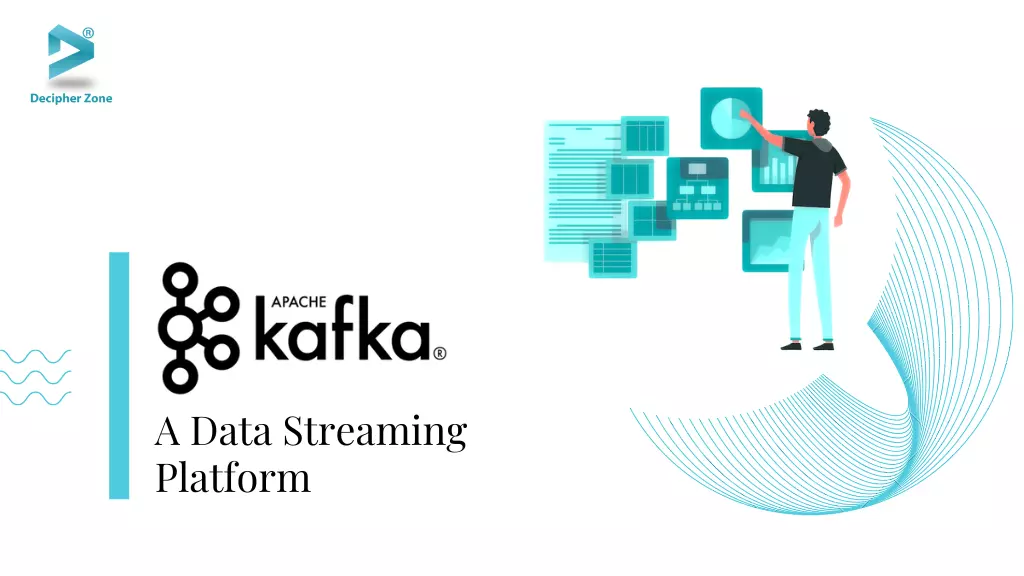
A Guide To Apache Kafka - A Data Streaming Platform
Apache Kafka? As long as we can remember, most developers have written applications that collect data in databases. What the database has taught us to do was thinking of the world in terms of things, such as trains, users, thermostats, etc. Database encourages thinking about those things with a state that is stored in it. Although this worked for decades, with the advancement in technology and the emergence of application development architectures like Microservices and Service-Oriented Architecture, it became difficult to manage distributed applications in databases. People began to think that, rather than thinking of things, it would be more useful to think of events.
Now events will have some states and descriptions of what had happened. But the primary goal behind using events is that it also indicates the time when something occurred.
Read: Top 10 NoSQL Databases
The database proved to be too large to store the orderly sequence of events, so we started using logs. Logs are not only easy to understand but also can be scaled easily, which was not the case when it came to databases.
Now that’s where Kafka emerged. But before we get into its fundamentals and work, let’s take a look at its background.
Apache Kafka - An Event Streaming Platform
Apache Kafka was originally developed by LinkedIn for collecting metrics and logs from the application to facilitate activity tracking. Now, Kafka is an open-source, distributed event store and streaming platform built using Java and Scala offered by Apache.
Apache Kafka allows developers to build real-time, event-driven, mission-critical applications that support high-performing data pipelines, data integrations, and streaming analytics.
But what do we mean by that?
Read: What is Apache Druid Architecture
Today, infinite data resources produce data record streams continuously, which includes events streams as well. Events are records of action along with the dates and times when they occurred. Usually, streaming data is generated by numerous data sources that send data records and events are actions that trigger other actions in a process.
So as an event streaming platform, Kafka needs to handle regular data flux while processing data incrementally and consecutively.
With Apache Kafka, you can achieve the following functions:
-
Subscribe and publish record streams.
-
Impactfully store record streams in the order of generated records.
-
Process recorded streams in real-time.
In short, Apache Kafka is built to handle streams of data and deliver them to multiple users. Massive data in Kafka isn't only transported between points A and B, but is transported anywhere and whenever you want.
It is an alternative to an enterprise messaging system that not only handles trillions of messages but also works with data streams every day.
Apache Kafka Fundamentals
It is essential to familiarize yourself with Kafka's fundamental concepts to understand how it works.
-
Topics
A topic is similar to a folder in a filesystem where events are the files stored inside it. Topics are multi-subscriber and multi-producer. It can have zero to many consumers that subscribe to the event and zero to many producers that write events to it.
Read: What is Apache Pinot Architecture
Unlike traditional messaging systems, the topic can be read as many times as needed because events are not deleted after one use. Instead, with Kafka’s per-topic configuration settings, you can define the duration of events after which old events will be deleted.
-
Partitions
A topic is divided into multiple parts known as partitions which are distributed over “buckets” located on different brokers of Kafka. This distribution of topics allows easy scaling of data as it enables client apps to read and write data to/from different brokers simultaneously. So whenever a new event is published to a topic, it is adjoined to its partitions. And events with the same key are written to the same topic partition and Kafka ensures that the consumer can read that event in the same order it was written.
Read: Dating App Development: Features Benefits & Cost
-
Topic Replication
Topic replication is the process that improves the capability of the topic to overcome a failure. Replication defines the number of topic replicas in the cluster of Kafka and can be defined at the topic level. It should be in the range of two to three replicas.
Read: Top 10 Web Technologies and Trends
Essentially, you can ensure that Kafka data is highly available and fault-tolerant by replicating topics across data centers or geographies so that you can do broker maintenance in the event of problems.
-
Offsets
The offset is the immutable and incremental identifier given to every message in the partition. This works similarly to the unique ID in a table of a database. However, offsets only have meaning for distinct partitions. It is one of the three metrics that can help in identifying and locating a message. Sequentially, first, there is the topic, then its partition, and lastly the message ordering (offset).
-
Producers
Similar to the messaging system, Kafka producers produce and send messages to the topic. A Kafka producer writes or publishes data on the topic within different partitions. It acts as a source of information in the cluster. It defines what stream of data (topic) and partitions a given message should be published on/to.
-
Consumers
A consumer in Kafka reads messages from Kafka topics and aggregates, filters, or enriches them with more information. It depends on the client library to manage low-grade network interfaces. It can be single or multiple instances (consumer group).
Read: Backend Developer Roadmap for 2020
By default, the consumer group is highly scalable, however, the library can only manage some of the challenges that arise with fault tolerance and scaling out.
-
Brokers
Brokers in Kafka refers to the servers available in the cluster of Kafka. A broker contains several topics with their partitions and can only be identified by an integer id. It allows consumers to acquire messages by partition, topic, and offset. By sharing information between each other directly or using Zookeeper, Broker creates a cluster in Kafka. A Kafka cluster contains one broker that acts as a controller.
Core APIs of Apache Kafka
There are five core APIs used to make Kafka work with Java and Scala. They are:
-
Admin API: It is used to inspect and manage brokers, topics, partitions, and other objects in the Kafka cluster.
-
Producer API: With this API, one can permit an application to publish/send record streams to one or more topics in the Kafka cluster.
-
Consumer API: It enables applications to read/subscribe to data streams and process them in the Kafka cluster.
Read: DevOps and Software Architecture
-
Kafka Stream API: With Kafka Stream API, one can implement stream processing microservices and applications. In addition to stateful operations and transformations, it offers a high level of functionality to process streams. The stream API enables transforming data from input to output topics.
-
Kafka Connect API: The connect API in the Kafka cluster is used to implement connectors that regularly pull and push source data either into the Kafka stream or some data flow system.
Read: Types of APIs
When To Use Apache Kafka
Although there are multiple use cases of Kafka, here we will look into some of the popular ones, as follows:
-
Website Activity Tracking
Apache Kafka was originally designed to trace website activity such as page views, user behavior, searches, and more. You can send different activities performed on the website to different topics in the Kafka cluster that will process it for real-time monitoring and load it to a data warehousing system like Hadoop for generating reports.
Read: What is Container Security and How to Secure Containers
-
Log Aggregation
Kafka can also be used instead of log aggregation tools that collect and process physical log files and put them on a file server. Using Kafka, details of files are abstracted to give clearer event data or log abstraction as message streams, leading to low latency and efficient support for consumption from multiple distributed data sources.
-
Event Sourcing
Kafka supports event sourcing for large stored log data, making it an excellent backend system for the application.
-
Messaging
Apache Kafka can be used as an alternative to traditional message brokers as it offers better throughput, replication, built-in partitioning, and fault tolerance, making it an incredible solution for large-scale message processing apps.
Read: Apache Druid vs Apache Pinot
-
Stream Processing
Apache Kafka has a lightweight library called Kafka Streams that helps in consuming raw data from Kafka topics and aggregating, processing, enriching, and transforming it into renewed topics for further processing and consumption.
-
Metrics
One can use Apache Kafka as a monitoring tool for operational data which involves aggregating statistics from distributed applications and producing centralized operational data fields.
Apache Kafka Business Benefits
Modern businesses receive continuous streams of data that they have to process and analyze in real-time. When Apache Kafka is implemented, businesses gain the following advantages:
-
Acting as a Buffer to Stop System Crash
Apache Kafka acts as an intermediary between source and target systems that receives processes and makes data available in real-time. As Apache Kafka has its own set of servers (cluster) it also stops your system from crashing by scaling up and down according to the requirements.
Read: How to Improve Security in Web Application Development
-
Reducing Multiple Integrations
Using Apache Kafka reduces the need to integrate multiple tools and systems to collect and process data. All you need to do is build one Apache Kafka integration for every producing and consuming system.
-
Real-Time Response
Adopting Apache Kafka allows a remarkable minimization of time between recording an event and data application reacting to it. It helps your business to acquire confidence and speed in the data-driven environment.
-
Data Accessibility
With all the data being stored in Apache Kafka, accessing any form of data becomes easier. The development team will now be allowed to access financial, website interaction, and user data straight through Kafka.
-
Higher Throughput
Apache Kafka decouples data streams and consumes data whenever needed. It also decreases latency as low as 10 milliseconds leading to quick data delivery in real-time. To manage large amounts of data, Apache Kafka horizontally scales to numerous brokers within a cluster.
Putting Apache Kafka into Action
Now that we have covered all the important topics like what Apache Kafka is, its fundamentals, core APIs, when to use it, and the benefit it offers to a business, it is time to put Apache Kafka into action.
Needless to say, Apache Kafka offers ideal solutions for data streaming and distribution in a lightweight method, it allows you to stream process messages to one or more applications. At its core, Kafka acts as a backbone for data distribution and sourcing in addition to offering reduced costs and improved time to market.
You should consider to hire developers from reputable and proficient firms like Decipher Zone Technologies if you are also looking to develop an Apache Kafka-based application.
Get a quote from us today!

